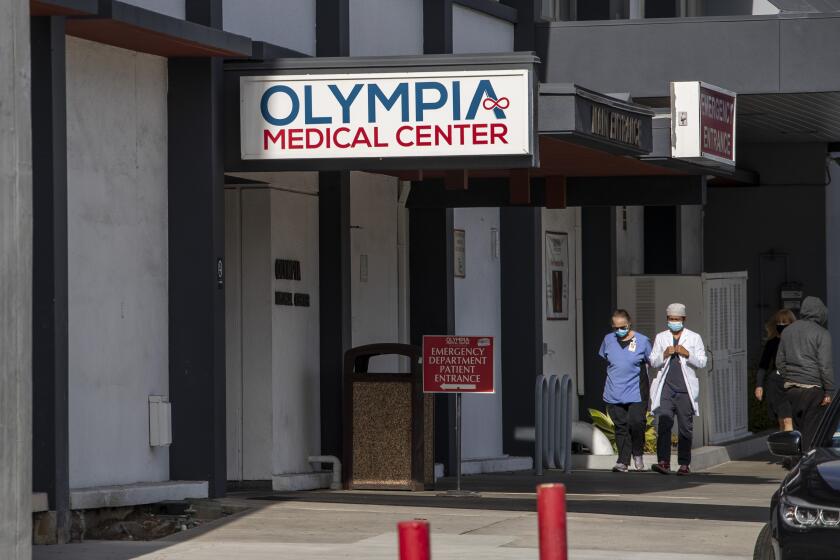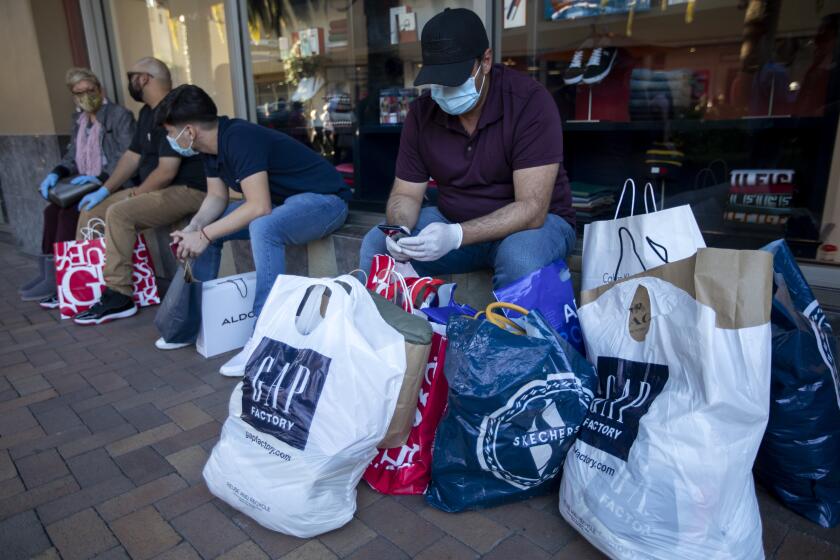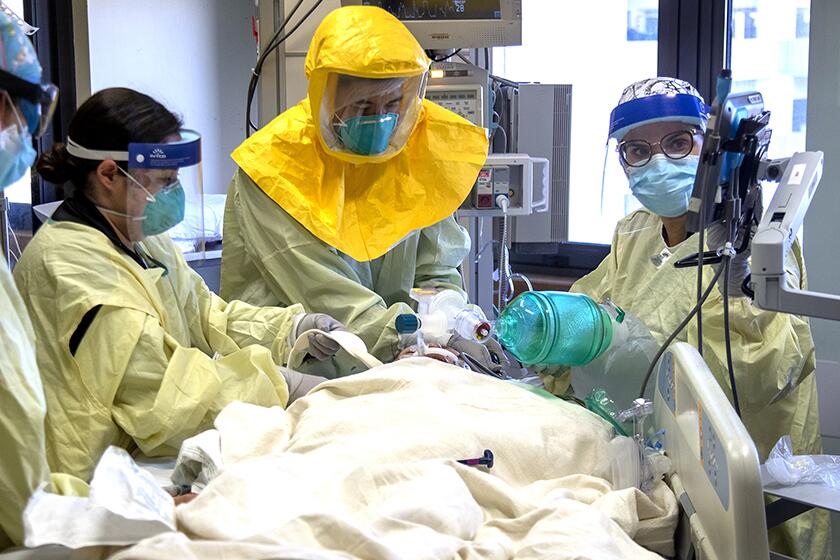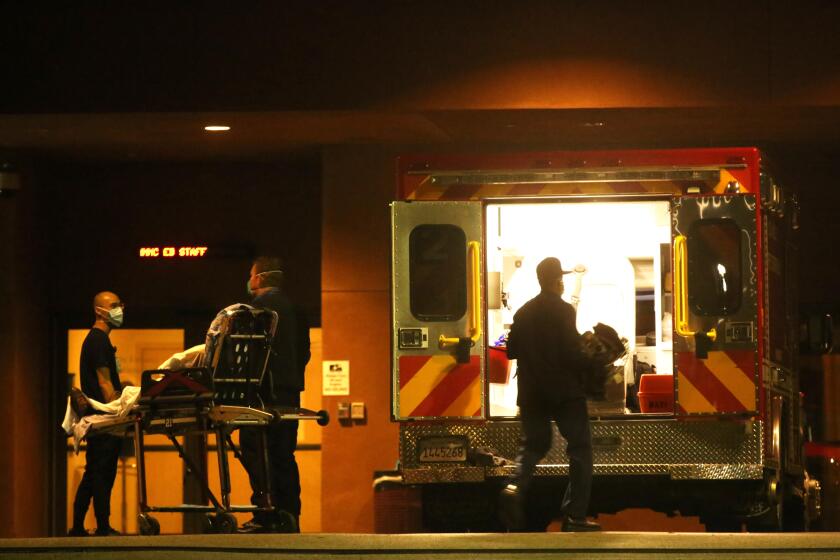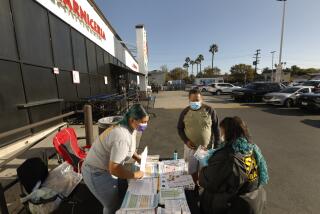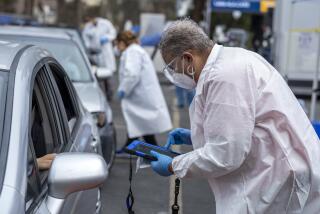California’s deadliest day yet for COVID-19: More than 670 fatalities
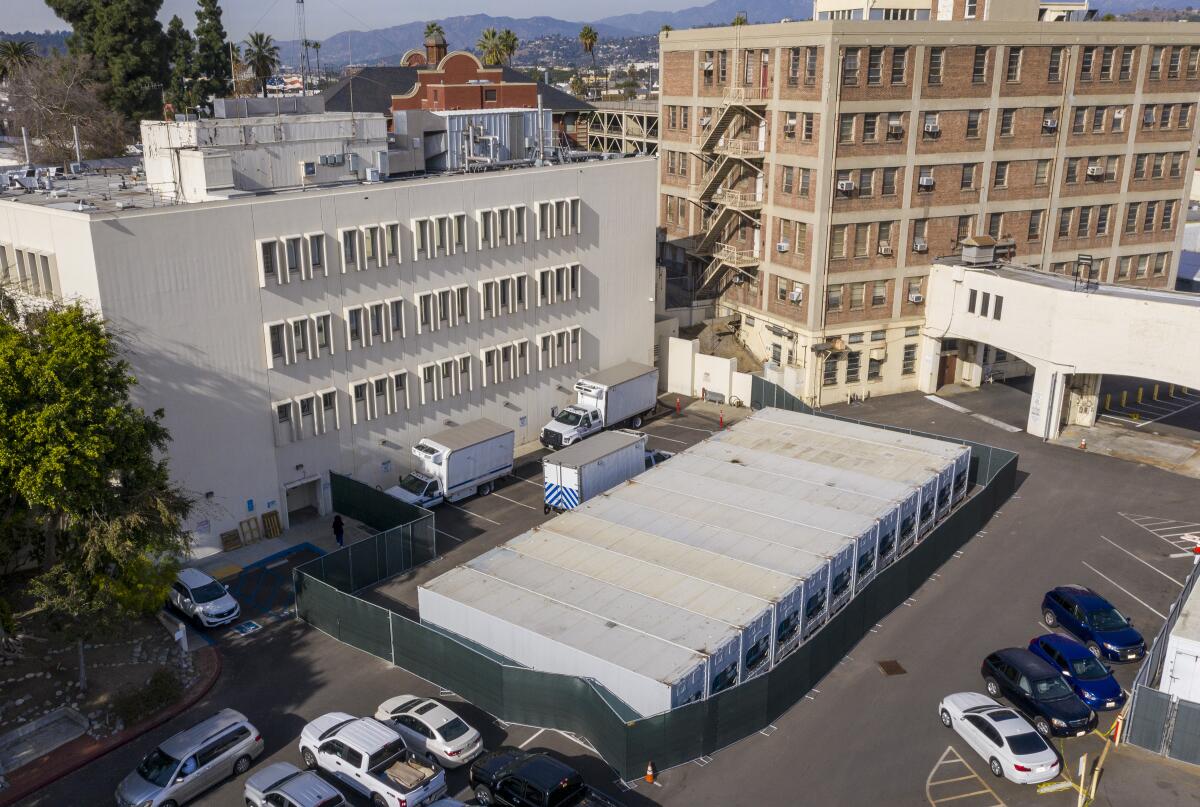
- Share via
Friday was the worst day yet for COVID-19 fatalities in California, as well as in Los Angeles County.
There were 676 deaths were reported in the state Friday, including 318 in Los Angeles County, according to a Times survey of health agencies. The figures easily top the previous single-day records: 575 deaths in California and 291 in L.A. County, both set on New Year’s Eve.
The records came on the one-year anniversary of L.A. County’s first health alert concerning the coronavirus.
What that alert called an “outbreak of pneumonia of unknown etiology in Wuhan City, China” has morphed in 12 months into the “most significant infectious disease” of the last century, said Dr. Paul Simon, chief science officer for the Los Angeles County Department of Public Health.
“The scale of the tragedy associated with this pandemic is unfathomable — even more so because so much of it was preventable,” Simon said during a briefing Friday.
Before the pandemic, L.A. County saw an average of 170 deaths a day, due to everything from car crashes to homicides to heart attacks. The county now is “seeing, clearly, more deaths from COVID alone than all other causes combined,” Simon said.
L.A. County has averaged 189 COVID-19 deaths a day over the past week. In early December, about 30 people in L.A. County were dying every day from COVID-19. Cumulatively, the county has reported 11,872 deaths.
The latest maps and charts on the spread of COVID-19 in Los Angeles County, including cases, deaths, closures and restrictions.
With the holiday season over and officials expressing dismay at how many residents appear to have ignored calls not to travel or celebrate with those outside their households, “we anticipate numbers of hospitalizations and deaths will remain high throughout this month,” Simon said.
The case count has again started to tick up. The county on Friday recorded its fifth-highest daily number of new coronavirus infections: 17,827 — well above last week’s daily average of 14,000. “This very clearly is the latest surge from the winter holidays and New Year’s, no question about it,” Simon said.
The leader of a trade group representing California hospitals said Friday that the peak of the current wave is expected to swamp the state’s healthcare system starting in a week or so.
Even though hospitals across the state are already contending with record numbers of COVID-19 patients, “we do anticipate the worst of this is to hit in another week or 10 days, and may continue into the month of February,” said Carmela Coyle, president and chief executive of the California Hospital Assn.
“This has been unprecedented for our state, unprecedented for the nation, unprecedented for the world,” she said during a conference call. “But we find ourselves today, in terms of the numbers, at a point where we are standing on a beach and watching a tsunami approach.”
With hospital morgues overcrowded and overwhelmed funeral homes forced to turn families away, the L.A. County coroner’s office is accelerating efforts to temporarily store corpses.
On Monday, six men and women from the California National Guard arrived to assist county workers in the loading of bodies from hospital morgues into one of 12 refrigerated storage units at the L.A. County Department of Medical Examiner-Coroner, said Sarah Ardalani, a spokeswoman with the coroner’s office. Additional members of the National Guard are expected to come next week.
Anticipating a surge in deaths, the coroner’s office last spring quadrupled its storage capacity for bodies from roughly 500 to at least 2,000 by adding the 12 trailers, according to Ardalani. An additional number of mobile refrigerated trailers can each hold about 25 bodies.
On Monday, the coroner’s office was holding 757 bodies.
To prepare for the surge, the Governor’s Office of Emergency Services has been preparing to dispatch 88 refrigerated trailers around the state that can serve as temporary morgues. Ten have already been designated for Los Angeles, San Bernardino, Imperial, Monterey and Sonoma counties.
The state agency said there’s a plan to set up an additional temporary morgue at the campus of the L.A. County coroner, with at least five trailers supplied by Cal-OES and another five supplied by L.A. County.
These resources will help “ensure we don’t get large backups, or, if we do have backups, they’re dealt with [with] respect and dignity [and] that we have the appropriate equipment in place or materials that are required for coroners and medical examiners to effectively deal with the decedents,” Cal OES Director Mark Ghilarducci said in a statement.
Other counties are also recording high numbers of fatalities. Ventura County on Friday reported 21 deaths, its second-highest single-day toll, following 26 on Monday. San Diego County reported 33 deaths Friday; San Bernardino County, 32; Riverside County, 29; and Orange County, 26.
After a sale to UCLA, Olympia Medical Center says it will shut down March 31. Workers and community members said they were blindsided by the decision.
In total, more than 29,000 Californians have died of COVID-19 — and the toll is climbing rapidly. .
When it comes to COVID-19’s impact on the hospital system, “the story was written weeks before, and that is this latency between viral spread and infection and the need for acute care,” Coyle said.
State officials have said that about 12% of people with diagnosed infections will need to be hospitalized. If that calculation holds true, then the roughly 278,000 cases confirmed statewide since New Year’s Day will lead to roughly 33,000 Californians in hospitals in the coming weeks.
L.A. County inspectors have issued 157 citations to businesses and churches for violating COVID-19 protocols since Dec. 1, some multiple times.
As of Thursday, the most recent day for which complete data are available, there were 21,855 coronavirus-positive patients hospitalized in California, with 4,812 in intensive care.
“We are anticipating another 15,000 individuals between now and Jan. 18 needing inpatient hospital care,” Coyle said. “This is a situation that is tough. It is tight. And it is tense.”
In L.A. County, hospitalizations have stabilized at a high number, hovering between 7,900 and 8,100 from Monday through Thursday. While the county has avoided some of the steep growth seen earlier in the surge, officials have warned that this level of hospitalizations is unsustainable, having already plunged the healthcare system into crisis, creating a shortage of available ambulances and forcing patients to wait hours for beds to open.
Researchers share which numbers they’re watching to forecast when California’s deadly COVID-19 surge will end.
Another surge, officials have said, could force hospitals to ration care if resources and staff become stretched too thin.
“It is difficult, I think, for many of us to relate to what our nurses and doctors and other hospital leaders are dealing with right now,” Coyle said. “There is no question that in some parts of the state, people who have dedicated and committed their lives to caring and to curing are seeing things they never anticipated seeing before.”
California posted more than 47,000 new coronavirus cases Friday, which may be the start of an increase in daily cases resulting from Christmas; Friday’s tally was significantly bigger than the daily average over the past week, which was about 42,000.
California has recorded a cumulative total of more than 2.6 million coronavirus cases
About one in five coronavirus tests performed daily in L.A. County are coming back positive, an astounding rate that underscores just how many people are infectious.
“We have the power to get this virus under control if we choose to do that, and it’s really up to us,” Dr. Christina Ghaly, the county’s director of health services, said this week.
Bay Area health officials warn that COVID-19 hospitalizations are threatening to worsen in the coming weeks.
But the worst is likely yet to come. Most of those hospitalized for COVID-19 in L.A. County were infected before Christmas. It won’t be until next week, experts say, that it becomes clear how much worse the post-holiday surge could be.
“We can’t stress enough that we have to, at this point, find our way to actually change the trajectory we’re on,” Barbara Ferrer, L.A. County’s public health director, said. “There really is no path forward to helping our hospitals unless we get the case numbers down. There just isn’t. High case numbers automatically translate into high numbers of people that need hospital care.”
Times staff writers Phi Do, Iris Lee and Lila Seidman contributed to this report.
More to Read
Sign up for Essential California
The most important California stories and recommendations in your inbox every morning.
You may occasionally receive promotional content from the Los Angeles Times.

